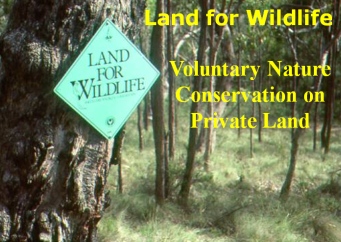Land for Wildlife
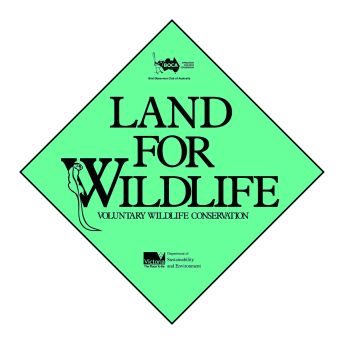
A positive way of looking after your habitats is to join the Land for Wildlife Scheme. This is a voluntary no cost way of recognising your commitment to wildlife habitat. You receive technical and educational support from a regional extension officer, an informative notes series and the schemes newsletters, the Land for Wildlife news.Members are welcome to attend field days and are informed of incentive programs as they arise.
To qualify for Land for Wildlife status a property must contain either existing remnant habitat or the landholder must be making an effort to create habitat on their property. Once an assessment is completed and you become a member a sign is issued which recognises your commitment to wildlife habitat.
Becoming a Land for Wildlife member does not alter your property rights in any way, it is a self-governed opportunity to contribute to sustained biodiversity through habitat protection.
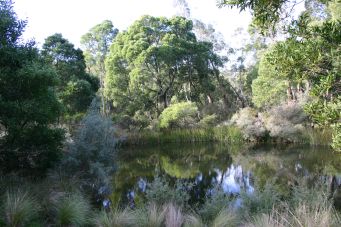 |
Wildlife habitat on private land can be crucial in contributing to the survival of native plants and animals, particularly in areas where landscape change has removed or significantly altered habitat. Retained habitats can also provide important links between properties and larger park or reserves. There are also many benefits to farming through reduced erosion, provision of stock shelter and in some cases reduced salinity, thereby increasing the land value and creating a more aesthetically pleasing environment.
Q1. What is Land for Wildlife?
Land for Wildlife is a voluntary scheme, which aims to encourage and assist private landholders to provide habitats for wildlife on their property, even though the property may be managed primarily for other purposes. Further detail is available on our General Information page.
Q2. What are the benefits of joining Land for Wildlife?
Land for Wildlife offers practical advice, technical information, training, support networks and opportunities for volunteers.
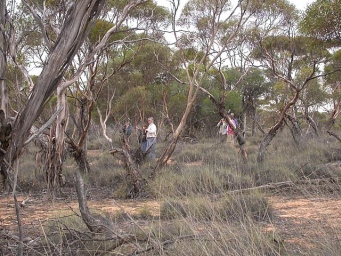 |
The Land for Wildlife scheme can offer:
- advice on the many important values of native vegetation, and how it may be retained, restored or re-established;
- advice on fauna occurring on or around the property, its particular ecological role and needs;
- advice on the availability of incentives, grants or other assistance with works on individual Land for Wildlife properties;
- advice on how to obtain assistance and support for community Land for Wildlife projects;
- contact with other landholders interested in nature conservation and sustainable management of their property;
- information on Land for Wildlife activity around the district, elsewhere in the state and nation;
- an opportunity to contribute to nature conservation in Victoria;
- recognition of commitment in the form of a Land for Wildlife sign to be displayed on the property.
Members receive a free newsletter and opportunities to attend field days and other events.
Members can benefit from contact with the network of some 5,500 Land for Wildlife properties and the ideas and inspiration provided by more than 12,000 landholders who manage them.
Q3. Does my property qualify for membership of Land for Wildlife?
Land for Wildlife welcomes all Victorian landholders who have a commitment to making a contribution to native plant and animal (biodiversity) conservation and whose property is able to provide significant habitat.
Land for Wildlife properties include farmland and other rural landholders. Members also include government authorities, municipalities, schools, corporations and others (including suburban properties under some circumstances). However, publicly owned and managed 'conservation land', such as land managed under the National Parks Act, is generally ineligible.
In general, properties should satisfy one or both of the following criteria:
- managed in a way which clearly pursues the maintenance and enhancement of native flora and fauna;
- and/or managed in a way which attempts to integrate nature conservation with other land management objectives.
Following application to join, an assessor will arrange to visit the property to discuss the landholder's plans, and to determine whether the property warrants registration.
Categories of membership:
- Fully Registered
- Working Toward Registration.
The full range of Land for Wildlife services are available to both categories with the exception that fully registered properties are eligible to display a Land for Wildlife sign and receive a certificate in recognition of their achievement.
For further information on guidelines relating to Land for Wildlife, please contact the Victorian Statewide Co-ordinator on 03 54304363.
Q4. My property does not include any retained habitat. What do I need to do before I can join Land for Wildlife?
Before being admitted to the scheme, property owners will need to establish that it is their intention to manage the property in a way which clearly pursues the maintenance and enhancement of native flora and fauna or in a way which attempts to integrate nature conservation with other land management objectives.
A property undergoing habitat restoration, but lacking any retained (original) habitat is eligible to apply to join the scheme so long as the owner can demonstrate the intention to satisfy the above criteria. In this case, the property may 'work toward registration' with the help of Land for Wildlife. Landholders wishing to achieve full registration are encouraged to apply as early as possible so that they can benefit from the advice that is available. Some basic steps landholders might take to qualify include:
- Development of a simple management plan for the property (regardless of its size) in which
- long-term plans are detailed.
- Replanting of land with indigenous plants, preferably in the form of communities and utilising
- species of flora naturally occurring in the region.
- Exclusion of stock from special or sensitive areas. Fencing around any remnant trees to
- permit regeneration.
- The use of indigenous plants in the garden as a food/shelter/breeding resource for wildlife.
- Control of harmful predators (e.g. cats), vermin and environmental weeds.
We recommend landholders apply for Land for Wildlife membership and obtain the advice of a Land for Wildlife assessor prior to undertaking any specific actions.
Q5. What do I need to say during a Land for Wildlife assessment of my property?
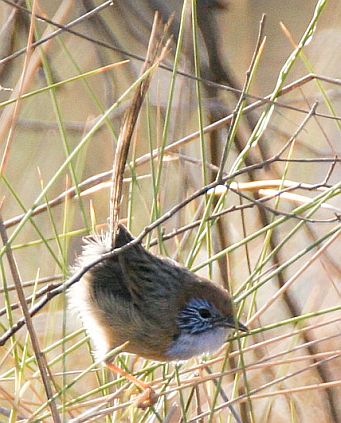 |
| Mallee Emu-wren Image: Tony Wilson
|
Land for Wildlife property assessment is an informal process where the landholder discusses with a registered assessor his or her plans for wildlife conservation on the property. The assessor will visit the property and explain the requirements for membership of Land for Wildlife and what benefits may be obtained by joining the scheme. The assessor will want to have a look around the property and will assist the landholder to complete a registration form containing details of the natural values of the property and the landholder's plans.
The landholder is given an opportunity to ask the assessor questions about the scheme and about wildlife management in general. This is an opportunity for landholders to obtain on-site advice and ideas for the future development of the property. Land for Wildlife recommends that questions are considered in advance of the assessor's visit.
An information sheet on preparing for a property assessment is available from Land for Wildlife. It contains some useful tips and prompts for questions landholders might wish to ask. The assessor may not be able to provide a detailed response to all questions during the visit but will endeavour to follow up with information immediately afterwards.
Q6. I don't have a property so am I able to be involved?
There are numerous opportunities for non-landholders to become involved. Go to our information on 'Land for Wildlife - opportunities for volunteers' available on the internet.
Q7. How do I obtain assistance with planning my property for wildlife?
You may obtain assistance from your nearest Regional Office of the Department of Environment and Primary Industries, Land for Wildlife Notes, covering various aspects of the management of properties for wildlife, are also available free-of-charge at Regional Offices, are provided to all members of the scheme.
Q8. Are native plants included in Land for Wildlife?
Because plants form a major part of wildlife habitat, the Land for Wildlife scheme places a great deal of emphasis on the importance of plants and plant communities and provides advice about our natural vegetation and its management.
Q9. Does Land for Wildlife membership alter the legal status of my property?
NO. Land for Wildlife membership will not alter the legal status of the property in any way nor will it diminish in any way the landholder's legal rights or control over the property. Commitment to the principles of Land for Wildlife is based on your personal decision to uphold its objectives.
Q10. Is access to my property, by hunters or the general public, altered by membership of Land for Wildlife?
NO. Land for Wildlife status does not convey the right of public access for hunting or any other purpose and does not confer any official "reserve" status whatsoever on the land. Your ownership of the land entitles you to take out an action for trespass against persons who are advised that they are trespassing on the property and do not leave after being given a reasonable time to respond. The police may be called and are empowered under the Summary Offences Act 1966 to take action. The Firearms Act 1996 prevents unauthorised shooting on or over private land. These entitlements are not related to Land for Wildlife.
Q11. Is my Land for Wildlife property exempt from a Fire Prevention Notice issued under section 41A of the Country Fire Authority Act 1958?
NO. Fire Prevention Notices may be issued if a Municipal Fire Prevention Officer forms the opinion that it is necessary, or may become necessary, to do so to protect life or property from the risk of fire or that there is no other procedure that addresses the risk. For detailed information on Fire Prevention Notices contact your local Shire Office and speak to the Municipal Fire Prevention Officer. Owners or occupiers have the right of appeal within 7 days of receiving a Notice. For further information on appeals contact the Country Fire Authority or local Land for Wildlife Extension Officer.
Q12. Can Land for Wildlife status be transferred when I sell my property?
NO. Land for Wildlife registration is conferred upon the landholder and may not be passed on to subsequent owners of that land. The new owner may apply to join Land for Wildlife, in which case a new assessment of the property will be arranged. Prior to the sale, landholders may wish to consider whether they wish to provide legal protection for the habitat using a conservation covenant (see below). Existing members can assist by encouraging purchasers to enquire about continuing Land forWildlife membership. Land for Wildlife offers a free service to members wishing to advertise theirproperty in the scheme newsletter and thereby attract a purchaser sympathetic to Land for Wildlife ideals.
Q13. How can I protect the conservation values on my property in the long term?
If you wish to protect the natural features of your property by law, you may apply to have the property covenanted under the Victorian Conservation Trust Act 1972. This process is quite separate, though complementary, to the Land for Wildlife scheme. As stated above, Land for Wildlife status does not alter the legal status of the property nor protect it from development should a new owner wish to manage the property in a different way.
A conservation covenant will protect the natural values of the property even when the property is sold to a new owner and provides a likelihood that subsequent owners also will appreciate, and preserve, these values. Contact the Trust for Nature for further information about conservation covenants.
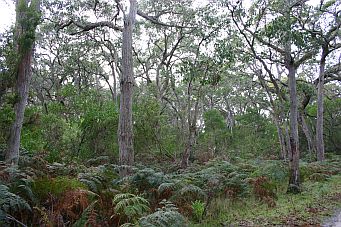 |
Land for Wildlife Extension Officers are available to offer advice on how to integrate fire safety with conservation of native plants and animals.
Contacts:
See DEECA Land for Wildlife home page for further information or Contact the Land for Wildlife Coordinator
Department of Energy, Environment and Climate Action LFW@delwp.vic.gov.au
See also:
- Newsletter of the Land for Wildife program, December 2022 - pdf
- Newsletter of the Land for Wildlife program, Spring 2021 - pdf
- Newsletter of the Land for Wildlife program, Spring 2020 - pdf
- Newsletter of the Land for Wildlife program, Summer 2019 - pdf
- Newsletter of the Land for Wildlife program, Spring 2018- pdf
- Newsletter of the Land for Wildlife program, Summer 2017 - pdf
- Newsletter of the Land for Wildlife program, Spring/Summer, Vol. 12. 1. 2016 - pdf
- Newsletter of the Land for Wildlife program, Winter Vol.11, 1, 2015 - pdf
- Conservation Management Networks
- Citizen Science
- Recommended references
- Natural Habitat Highlights - activities, updates and information to help you manage your land for wildlife.
SWIFFT video conference talks related to Land for Wildlife
- Introduced predators - fox and feral cat
- Habitat enhancements
- Moths & butterflies conservation
- Bat ecology & conservation
- Biodiversity conservation in urban and fringing landscapes
- Threatened Possums and Gliders in Victoria
- Conservation of remnant trees in rural environments
- Wildlife on farms


